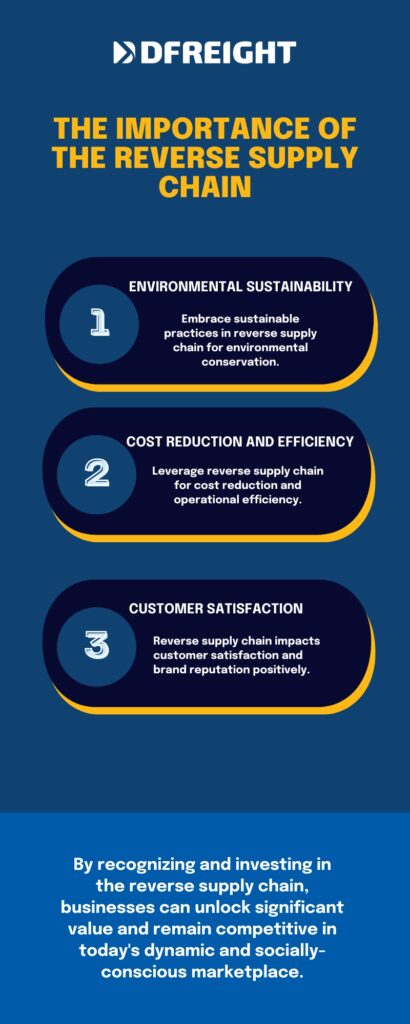In today’s globalized world, supply chains play a critical role in ensuring the efficient flow of goods and services from suppliers to end consumers. A well-managed supply chain enables businesses to meet customer demands, optimize costs, and maintain a competitive edge in the market. However, the traditional supply chain model primarily focuses on the forward flow of products, neglecting an equally important aspect known as the reverse supply chain.
Ready to revolutionize your logistics operations? Choose DFreight, your experienced digital freight forwarder, and unlock a new era of efficiency and convenience. Experience seamless shipping, real-time tracking, and cost-effective solutions. Contact us today to streamline your supply chain and take your business to new heights!
Table of Contents
What is a Supply Chain?
Before diving into the concept of the reverse supply chain, it’s essential to understand the basics of a conventional supply chain. A supply chain encompasses all the activities involved in the production, procurement, transformation, and distribution of goods or services from their origin to the final destination. It involves various entities, such as suppliers, manufacturers, distributors, retailers, and customers, collaborating to deliver products efficiently.
The traditional supply chain follows a linear progression, starting from the acquisition of raw materials, passing through the manufacturing and distribution processes, and ending with the sale of the finished products to customers. This forward supply chain focuses on fulfilling customer demands, optimizing inventory levels, and minimizing costs along the way.
Understanding the Reverse Supply Chain
While the forward supply chain deals with the flow of products from manufacturers to end consumers, the reverse supply chain encompasses the processes involved in managing product returns, repairs, refurbishments, recycling, and disposal. It deals with the movement of products from consumers or end-users back to the manufacturer or distributor.
The reverse supply chain is also known as reverse logistics, as it involves the reverse flow of goods, information, and funds. It aims to recapture value from products that have reached the end of their lifecycle, either due to defects, damage, customer dissatisfaction, or obsolescence.
The reverse supply chain involves several critical activities, including product returns management, repair and remanufacturing processes, recycling and waste management, as well as the disposition of assets and materials. It requires effective coordination, visibility, and integration with the forward supply chain to ensure maximum efficiency and sustainability.
Understanding and effectively managing the reverse supply chain is becoming increasingly important for businesses due to several factors. These include the growing emphasis on environmental sustainability, the need for cost reduction and efficiency, and the impact on customer satisfaction and brand reputation.
In the following sections, we will explore the importance of the reverse supply chain, its key components, challenges in its management, and strategies for effective implementation in this field.
The Importance of the Reverse Supply Chain
The reverse supply chain holds significant importance for businesses across industries. It offers several benefits that directly contribute to their overall success and sustainability. Let’s explore some of the key reasons why the reverse supply chain is crucial for organizations.

Environmental Sustainability
In today’s era of increased environmental awareness, businesses are under growing pressure to adopt sustainable practices. The reverse supply chain plays a vital role in this regard by enabling companies to effectively manage and minimize waste, reduce resource consumption, and promote circular economy principles.
Through processes such as product returns, refurbishment, repair, and recycling, the reverse supply chain facilitates the recovery of valuable materials from end-of-life products. This reduces the need for raw material extraction and minimizes the environmental impact associated with manufacturing new products from scratch. By embracing sustainable practices in the reverse supply chain, businesses can contribute to conserving resources, reducing greenhouse gas emissions, and preserving the ecosystem for future generations.
Cost Reduction and Efficiency
The reverse supply chain also offers substantial opportunities for cost reduction and operational efficiency. By effectively managing product returns, repairs, and refurbishments, businesses can recover value from products that would otherwise be considered waste or written off as losses.
Optimizing reverse logistics processes, such as transportation, inventory management, and disposition of assets, helps reduce costs associated with handling returns and managing reverse flows. By streamlining these operations, businesses can minimize storage costs, transportation expenses, and labor requirements.
Moreover, a well-executed reverse supply chain can improve overall supply chain visibility and enable better forecasting and planning. This, in turn, leads to enhanced inventory management, reduced stockouts, and improved demand fulfillment. By leveraging the reverse supply chain for cost reduction and efficiency gains, businesses can achieve a competitive advantage and strengthen their financial performance.
Customer Satisfaction and Brand Reputation
The reverse supply chain has a direct impact on customer satisfaction and brand reputation. A seamless and customer-centric returns management process enhances the overall shopping experience for consumers. It instills confidence in customers, knowing that they can easily return or exchange products if they are dissatisfied or encounter any issues.
Efficient product repairs, refurbishments, and warranty services contribute to increased customer loyalty. Businesses that prioritize the reverse supply chain effectively address customer concerns, ensuring prompt resolution and minimizing any inconvenience caused. This, in turn, leads to positive word-of-mouth referrals and repeat business.
Moreover, organizations that demonstrate a commitment to sustainability through their reverse supply chain practices enhance their brand reputation. Customers are increasingly conscious of environmental issues and prefer to support businesses that prioritize sustainability. By implementing eco-friendly initiatives, recycling programs, and responsible disposal methods, companies can differentiate themselves in the market, attract environmentally-conscious customers, and build a positive brand image.
In summary, the reverse supply chain is essential for organizations to achieve environmental sustainability, drive cost reduction and efficiency, and enhance customer satisfaction and brand reputation. By recognizing and investing in the reverse supply chain, businesses can unlock significant value and remain competitive in today’s dynamic and socially-conscious marketplace.
Key Components of the Reverse Supply Chain
The reverse supply chain consists of several critical components that enable businesses to manage the flow of products in the reverse direction effectively. Let’s explore the key components that design a reverse supply chain.
Product Returns and Refurbishment
Product returns management is a fundamental component of the reverse supply chain. It involves establishing processes and systems to handle customer returns efficiently. When customers return products due to defects, damages, or dissatisfaction, businesses need to ensure seamless handling, inspection, and disposition of these items.
An effective returns management process involves capturing accurate information about the returned products, assessing their condition, and determining the appropriate course of action. This can include refurbishing, retesting, repackaging, or reselling the products as appropriate. By efficiently managing product returns and refurbishment, businesses can minimize waste and recapture value from returned items.
Product Repair and Remanufacturing
Product repair and remanufacturing are essential components of the reverse supply chain, particularly for durable goods. When products malfunction or require servicing, businesses can leverage repair and remanufacturing processes to extend their lifespan and reduce the need for new replacements.
Repair involves fixing specific issues or defects in a product to restore its functionality. This can be done either by the manufacturer or through authorized repair centers. Remanufacturing, on the other hand, goes a step further by disassembling, cleaning, replacing worn-out components, and rebuilding the product to a like-new condition.
Implementing efficient repair and remanufacturing processes can significantly reduce costs associated with warranty claims, customer complaints, and new product production. It allows businesses to extract additional value from returned or faulty products and offers refurbished or remanufactured alternatives to customers at a lower cost.
Recycling and Waste Management
The reverse supply chain also encompasses recycling and waste management practices. When products reach the end of their lifecycle or are deemed irreparable, responsible disposal and recycling become crucial.
Recycling involves breaking down products into their constituent materials and using them as inputs for the production of new products. By implementing recycling programs, businesses can recover valuable resources, minimize the extraction of raw materials, and reduce the environmental impact associated with manufacturing processes.
Effective waste management is another vital aspect of the reverse supply chain. It involves properly disposing of materials that cannot be recycled or reused. This ensures compliance with environmental regulations and prevents pollution or harm to ecosystems.
By integrating recycling and waste management into the reverse supply chain, businesses demonstrate their commitment to environmental sustainability and circular economy principles. They contribute to reducing waste generation, conserving resources, and minimizing their ecological footprint.
By focusing on these key components, businesses can enhance their reverse supply chain management, reduce costs, minimize waste, and promote sustainable practices. Embracing these components not only contributes to environmental stewardship but also provides opportunities for cost savings, value recovery, and improved customer satisfaction.
Challenges in Managing the Reverse Supply Chain
While the reverse supply chain offers numerous benefits, it also presents unique challenges that businesses must overcome to ensure effective management. Let’s explore some of the key challenges associated with managing the reverse supply chain.
Reverse Logistics and Transportation
One of the primary challenges in the reverse supply chain is the complexity of reverse logistics and transportation. Unlike the forward supply chain, where products move from suppliers to customers, the reverse flow involves handling returns, repairs, refurbishments, or recycling. Managing the logistics of these reverse flows can be challenging due to various factors.
Firstly, the volume and variety of returned products can be unpredictable and may require flexible transportation and logistics solutions. Products may be returned from different locations, making consolidation and coordination challenging. Additionally, the reverse logistics process often involves multiple stakeholders, including customers, retailers, and service providers, which can introduce complexities in coordinating the reverse flow.
Optimizing reverse logistics and transportation requires careful planning, efficient routing, and coordination among various entities involved. It involves finding cost-effective methods to handle reverse flows, managing inventory in reverse logistics centers, and ensuring timely and accurate delivery to the appropriate destinations. Overcoming these challenges is crucial to maintain operational efficiency and minimize costs in the reverse supply chain.
Quality Control and Inspection
Maintaining quality control and inspection processes is another significant challenge in the reverse supply chain. Returned products may have defects, damages, or wear and tear, and it is essential to assess their condition accurately.
Conducting thorough quality control and inspection of returned items is crucial to determine the appropriate course of action, such as repair, refurbishment, or disposal. However, this process can be time-consuming and resource-intensive, particularly when dealing with a high volume of returns. Ensuring consistency and accuracy in assessing product condition is vital to avoid errors or discrepancies.
Implementing robust quality control and inspection procedures requires trained personnel, standardized protocols, and efficient documentation. Leveraging technologies such as automated inspection systems, machine vision, or AI-driven algorithms can enhance accuracy and speed up the inspection process. By overcoming these challenges, businesses can make informed decisions regarding the disposition of returned products and maintain customer satisfaction.
Data Management and Tracking
Effective data management and tracking pose significant challenges in managing the reverse supply chain. The reverse flow involves handling large volumes of data related to returned products, customer information, repair or refurbishment processes, and disposition outcomes.
Accurate data management is crucial for tracking and tracing returned products, ensuring visibility into the reverse supply chain, and analyzing trends and patterns. However, disparate systems, inconsistent data formats, and lack of integration across stakeholders can hinder efficient data management.
Implementing robust data management systems, including customer relationship management (CRM) tools, enterprise resource planning (ERP) systems, and data analytics platforms, can help overcome these challenges. It enables businesses to track and analyze data related to product returns, repair cycles, warranty claims, and customer feedback. This data can provide valuable insights for process optimization, identifying recurring issues, and improving overall reverse supply chain performance.
Overcoming the challenges associated with reverse logistics and transportation, quality control and inspection, and data management and tracking is critical to effectively managing the reverse supply chain. By addressing these challenges, businesses can streamline operations, reduce costs, enhance customer satisfaction, and maximize the value recaptured from returned products.
Strategies for Effective Reverse Supply Chain Management
Managing the reverse supply chain requires careful planning, coordination, and the implementation of effective strategies. To optimize the flow of products in the reverse direction and capture maximum value, businesses can adopt the following strategies:
Designing for Reversibility
One of the key strategies for effective reverse supply chain management is to design products with reversibility in mind. This involves considering the entire lifecycle of the product during the design phase, including ease of disassembly, repairability, and recyclability.
By designing products for reversibility, businesses can simplify the processes of disassembly, component replacement, and repair. This not only reduces the time and effort required for repairs but also enhances the likelihood of successful refurbishment or remanufacturing.
Additionally, incorporating standardized parts and modular designs allows for easier identification and replacement of faulty components, further facilitating the repair and reverse logistics processes. Designing for reversibility helps businesses maximize the value recovery from returned products and minimize waste.
Streamlining Reverse Logistics Processes
Efficient management of reverse logistics processes is crucial for effective reverse supply chain management. Streamlining these processes helps minimize costs, improve operational efficiency, and enhance customer satisfaction.
To streamline reverse logistics, businesses can focus on optimizing return handling, transportation, and warehousing processes. This includes establishing clear and user-friendly return policies, providing convenient return options for customers, and ensuring efficient collection and consolidation of returned products.
Investing in technology solutions such as barcode scanning, RFID tracking, and automated sorting systems can enhance visibility and tracking throughout the reverse logistics process. Leveraging data analytics can also provide valuable insights into return patterns, enabling businesses to identify root causes and implement corrective measures.
Moreover, implementing efficient inventory management systems for returned products and maintaining clear documentation and communication with stakeholders can streamline reverse logistics operations. By reducing lead times, minimizing handling costs, and improving overall process efficiency, businesses can unlock significant value in the reverse supply chain.
Collaborative Partnerships and Reverse Channels
Collaborative partnerships and reverse channels are instrumental in effective reverse supply chain management. Collaborating with suppliers, distributors, and service providers can help create a seamless flow of products in the reverse direction and optimize the value recovery process.
Establishing strategic partnerships with refurbishment centers, repair facilities, or recycling vendors allows businesses to leverage specialized expertise and resources. These collaborations enable efficient handling of returned products, ensuring timely repairs, refurbishments, or appropriate disposal.
Implementing reverse channels involves leveraging existing distribution channels to handle reverse flows. This includes utilizing retail stores or authorized service centers as collection points for returns or establishing dedicated channels for product collection.
Collaborative partnerships and reverse channels enhance coordination, reduce transportation costs, and improve the overall efficiency of the reverse supply chain. By leveraging the expertise and infrastructure of partners, businesses can enhance the value recovery process and deliver superior customer experiences.
By implementing these strategies, businesses can effectively manage the reverse supply chain, reduce costs, improve sustainability, and enhance customer satisfaction. Designing for reversibility, streamlining reverse logistics processes, and establishing collaborative partnerships are crucial steps in building a robust and efficient reverse supply chain.
Final Verdict
In conclusion, the reverse supply chain is a critical aspect of modern business operations. By recognizing its importance, addressing challenges, and implementing effective strategies, businesses can achieve environmental sustainability, reduce costs, enhance customer satisfaction, and strengthen their position in the market. Embracing the reverse supply chain as a strategic asset empowers businesses to thrive in an ever-evolving, socially-conscious marketplace.
What is a reverse supply chain?
The reverse supply chain refers to the management of products in the opposite direction of the traditional supply chain, focusing on activities such as product returns, repairs, refurbishments, and recycling.
Why is the reverse supply chain important?
The reverse supply chain is important for various reasons. It promotes environmental sustainability by reducing waste, conserving resources, and minimizing the impact on ecosystems. It also offers cost reduction opportunities through value recovery from returned products and efficient repairs. Additionally, it enhances customer satisfaction and brand reputation by providing seamless returns processes and sustainable product options.
What are the key components of the reverse supply chain?
The key components of the reverse supply chain include product returns and refurbishment, product repair and remanufacturing, and recycling and waste management. These components enable businesses to effectively handle returned products, extend product lifecycles, and minimize waste generation.
What challenges are associated with managing the reverse supply chain?
Challenges in managing the reverse supply chain include complex reverse logistics and transportation, maintaining quality control and inspection, and efficient data management and tracking. Overcoming these challenges requires careful planning, technology integration, and collaborative partnerships.
What strategies can businesses adopt for effective reverse supply chain management?
Businesses can adopt strategies such as designing products for reversibility, streamlining reverse logistics processes, and establishing collaborative partnerships and reverse channels. These strategies enhance efficiency, reduce costs, and promote sustainable practices in the reverse supply chain.














